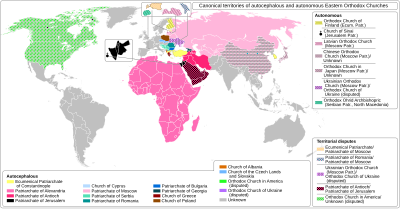Canonical territory
Canonical territory (Каноническая территория, Kanonitscheskaja territorija ) is a canonical term of Orthodoxy. It is particularly important for the Russian Orthodox Church (ROK) and its ecumenical relations.
Historically, the concept goes back to the old church , in which Christianity was undivided and a bishop was responsible for his diocese . Specifically, the church existed as a network of episcopal seats that was closely knit, depending on the region, with the bishops standing in communion with one another. In the further historical development, the church developed its regional structure according to the structures of the Roman Empire . This tradition was continued in Orthodoxy, so that in the 20th century the ROK drew the borders of dioceses and metropolises so that they coincided with the state administrative units of the Soviet Union .
In 2000, the ROK determined the boundaries of its canonical territory in such a way that it covered the territory of the former Soviet Union with the exception of Georgia and Armenia , as well as China, Mongolia and Japan. Belarus (Exarchate) and the Ukraine, Latvia, Moldova and Estonia have a kind of ecclesiastical self-government, but no autonomy in the sense of Orthodox church law.
From the point of view of the ROK, the canonical territory is an area in which it alone is authorized to conduct mission and evangelism . Non-religious people who live in this territory are seen as “potentially Orthodox believers” who should actually belong to the ROK, even if they are not church members (for example as a result of Soviet upbringing). Church planting of other churches on their canonical territory is opposed by the ROK as proselytism .
Web links
- Jakob Speigl : The principle of canonical territory - an ecclesiological topic . In: Ost-West 2/2003, pp. 157–158.
literature
- Thomas Bremer : Cross and Kremlin: History of the Orthodox Church in Russia . Herder, 2nd updated and expanded edition, Freiburg / Basel / Vienna 2016. ISBN 978-3-451-34877-8 .
- Hans-Dieter Döpmann : Church identity and canonical territory . In: Thomas Bremer (ed.): Religion and Nation: the situation of the churches in Ukraine . Harrassowitz, Wiesbaden 2003, pp. 53-66. ISBN 3-447-04843-3 .
- Johannes Oeldemann: The Concept of Canonical Territory in the Russian Orthodox Church . In: Der Christliche Osten 2/2003, pp. 92–98.
